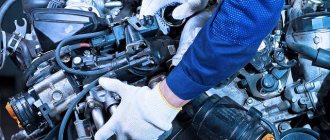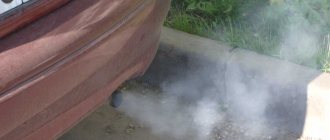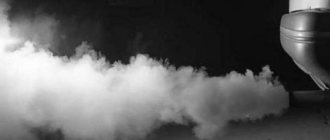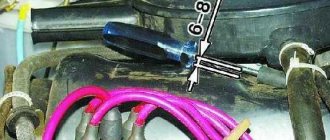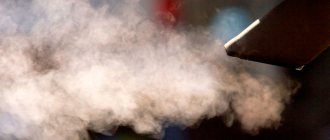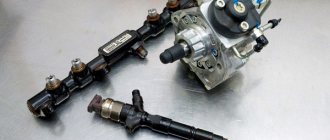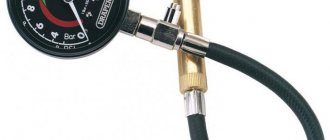Black smoke from the exhaust pipes can be found in all types of engines - running on diesel fuel, gasoline, liquefied gas. If black smoke comes from the exhaust, this means that there is an ignition problem or an over-rich air-fuel mixture. Therefore, black exhaust is, first of all, an indicator of high toxicity of gases, increased fuel consumption and the presence of a problem in the fuel system.
Usually the problem is expressed in the fact that when you press the accelerator pedal (especially “cold” and/or when pressing hard), black smoke comes out of the exhaust pipe. At the same time, the engine often works unstably, “troits”, and starts poorly, especially after a long period of parking (for example, in the morning). In this case, it is necessary to distinguish between the concepts of “black smoke” and “blue smoke”, since these two signs indicate various breakdowns in the engine.
Cause of black smoke from exhaust
It is interesting that, regardless of what type of engine such a misfortune happens to, the common cause in most cases is the same, and it is that a too rich air-fuel mixture is supplied to the combustion chamber. But why, you need to consider a specific type of engine, since a gasoline engine produces much less black smoke than a diesel engine.
In general, the reasons for the appearance of black smoke from the exhaust may be problems with the ignition system, power system, or fuel injection system.
As for the ignition system, the two most common options are problems with the spark plugs or with the coil/coils. If the spark plugs do not produce a spark with the required power, then the air-fuel mixture does not burn completely. The result of this is, among other things, black carbon deposits on the electrodes. And sometimes the spark plugs are completely filled with fuel, making it difficult to start the engine. In a diesel engine, there are glow plugs, and if they are not heated correctly, they cause increased smoke, because the fuel is then not burned.
In a gasoline engine, the result of incomplete combustion of fuel can be the coil. If it is damaged, misfire may occur in individual cylinders.
In the fuel delivery system, problems in this context may be related to the fuel pump and/or fuel injectors. If they partially fail, fuel may be overfilled beyond the norm, resulting in the formation of an enriched air-fuel mixture.
Separately, it is worth focusing on low-quality fuel. Unfortunately, in our realities, many motorists are faced with the fact that gas stations sell low-quality fuel. This applies to all types of fuel - gasoline, diesel fuel, liquefied gas. If there is a significant presence of non-combustible impurities in their composition, the normal operation of the engine will be disrupted, which can lead, among other things, to the appearance of black smoke from the exhaust.
Please note that black exhaust is very toxic and not even a catalytic converter can handle it. However, there are subtleties that are characteristic of certain types of motors.
Black smoke from carburetor exhaust pipe
If an engine with a carburetor has black smoke coming out of the exhaust pipe, the first thing you need to do is check the carburetor itself. Most often, the so-called “overfill” occurs, that is, the amount of incoming gasoline exceeds the norm. In turn, this can happen for two reasons.
The first is that the needle valve (colloquially called a “needle”) is faulty. It simply sticks and excess fuel passes through it. The second reason is clogged jets. They are small diameter nozzles. Often, when using low-quality domestic fuel (or simply over time), they become clogged, causing an over-enriched mixture to be created in the carburetor.
Often, to solve the problem, it is enough to clean it with a carb cleaner. If simple cleaning does not help, you need to buy a carburetor repair kit, which usually includes a new valve and jets. Replace them accordingly. At the end, you need to correctly configure the carburetor and set the gasoline level in the chamber.
Why is this happening
Most often, carburetor engines suffer from this sin, that is, those in which the preparation of the working mixture is carried out by a half-forgotten device that works on the principle of suction of fuel into the flow of outside air flying through the diffusers. There are almost no more of them left, but by examining such a simple device it is easier to come to an understanding of the pathological processes during the organization of combustion in cylinders.
Carburetor engine
Initial situation to consider: black smoke from the exhaust pipe, gasoline, carburetor. Although there are also carburetor diesel engines or gasoline engines with more complex fuel equipment. But there the problems may look different, although the soot is the same everywhere.
The dosage of the air-fuel mixture composition here occurs exclusively by carburetor systems. The device is quite complex; even the most ordinary gasoline sprayer from old VAZ cars has approximately nine dosing systems operating sequentially or partially simultaneously. And any of them can produce excess fuel, which will not burn completely, but will release soot in the exhaust.
Most often, this is caused by improperly functioning main dosing systems. They contain air and fuel nozzles, the ratio of the flow sections of which provides the so-called stoichiometric composition, that is, a strictly defined amount of hydrocarbons per unit of oxygen mass. This mixture is called normal.
There are other mixture compositions:
- Depleted. There is slightly less gasoline than in the optimal stoichiometry.
- Poor thing. There is very little gasoline; it is even difficult to ignite the mixture.
- Enriched. A mixture for power modes, the engine will work at maximum efficiency, but uneconomically.
- Rich. She burns just as badly as the poor one.
It is in the latter case that noticeable soot release begins in the exhaust. There may be several reasons why the main metering systems of carburetor chambers fall into this mode:
- difficulties with pumping air into the cylinders, for example, a dirty air filter or foreign particles in the air jets;
- excess fuel due to abnormal cross-sections in the fuel metering elements, the main jet can simply get unscrewed;
- grossly violated adjustment of the fuel level in the float chamber;
- mechanical problems with the throttle valves in multi-chamber carburetors.
But the problem isn't necessarily just related to basic inpatient dosing. Any of the carburetor systems can add excess gasoline. For example, leaky diaphragms, dropped emulsion tubes, or an abnormally activated idle system.
Diagnostics is made based on the readings of a gas analyzer or visually, based on the color of the exhaust. The carburetor needs to be disassembled, flushed or mechanically repaired.
Smokes black from the exhaust injector
Answering the question why black smoke comes from the exhaust pipe of an injection engine, three main reasons can be identified.
Problems with injectors
On an injection engine, as on a carburetor engine, the injectors become clogged over time, especially when using low-quality fuel. In this case, first a situation occurs when, due to clogged injectors, there is not enough fuel, and then a certain moment comes when the tightness of the needle valve is broken, they begin to let an excessive amount of fuel into the combustion chamber. Naturally, under such conditions the engine will operate unstably, “triple”, the engine speed will “float”, especially at idle.
In this case, it is recommended to clean the injector nozzles. It is recommended to carry out this procedure using special cleaning products every 60...70 thousand kilometers, regardless of what kind of gasoline you use.
Faulty sensors
The operation of the injection engine is based on commands from the electronic control unit (ECU), which, in turn, receives information from sensors located in the engine. Accordingly, if incorrect information is received, the control unit may give a command to form a too rich mixture, which will lead to the appearance of black smoke from the exhaust pipe. What kind of fuel is used, gas, gasoline or diesel fuel, does not matter in this case. In this case, black smoke will only be an external sign of a malfunction. Also, the car will lose its dynamic characteristics, the engine will “trouble”, “sneeze”, and the idle speed will fluctuate.
To diagnose sensors, you can use either a scanner or a regular multimeter. When black smoke occurs when starting a cold engine, then first of all it is worth checking the air flow/pressure sensor, engine temperature, throttle valve, and if on a hot engine, then the oxygen sensor (lambda).
Fuel pump
For cars equipped with injection engines, the fuel pump is located directly in the fuel tank, and from there it supplies gasoline under high pressure to the fuel rail. In rare cases, it happens that the pump produces too high a pressure, that is, higher than necessary, which causes an overflow in the injection chamber, and as a result, black smoke from the exhaust when starting and/or when idling and while driving .
Diagnosing a fuel pump is a rather complicated matter, and it is best to entrust it to specialists. In particular, the pressure and performance they produce are checked using special instruments. Since often increased pressure is produced not only by the pump itself, but by a faulty regulator.
Other faults
The engine can smoke soot even if there are no faults in the fuel system, no matter what it is. Almost any defect disrupts normal combustion:
- abnormal operation of the turbocharger in supercharged engines;
- changes in valve timing associated with wear or breakdowns;
- violations in the operation of automatic ignition timing devices, both mechanical and electronic;
- severe contamination of the exhaust gas recirculation system, due to which the engine lacks oxygen in the gas entering the intake;
- deposits or presence of foreign objects in the intake tract;
- decreased compression, general engine wear.
It is especially worth considering the situation in which black smoke is present when starting a cold engine. To start the engine in the cold season, it is necessary to further enrich the mixture due to the fact that some of the gasoline condenses and is difficult to ignite with a standard spark. Two situations arise when soot emission is a necessary measure and when the operation of the starting system is disrupted. Smoke will appear anyway. The only difference is that the calculated cold start mode leads to the desired result faster, after which the smoking disappears. A misregulated system will not allow the engine to start quickly and will continue to smoke until it warms up completely. In injection engines, it is necessary to check the temperature sensor, and in carburetor engines, the settings of the starting air damper.
The use of high-quality fuel is also important. Gasoline will produce black smoke from the exhaust pipe if its hydrocarbon composition is disturbed. After all, the ideal stoichiometric ratio only applies when the fuel consists of fractions defined by the standard. All kinds of counterfeit liquids obtained from oil using the simplest methods burn completely differently; they require much more air, which the fuel system is not designed for. As a result, even a perfectly good car will smoke. This can only be cured by replacing the contents of the tank before irreversible changes occur.
Black smoke from diesel exhaust
Please note that the exhaust of even a working diesel engine has a black-blue tint, unlike gasoline or liquefied gas. Therefore, it is necessary to distinguish between the normal amount of exhaust gases and their excessive amount, especially taking into account the fact that the gases have a characteristic black color.
Any diesel engine is characterized by 4 main reasons why black smoke comes out of the exhaust pipe:
- lack of air (both clogged air filter and damage to the intake pipe);
- weak compression;
- leaking injectors (especially noticeable when you press the gas sharply or when driving with a load);
- the injection timing angle is broken (an early angle leads to increased soot formation).
More about these and other reasons below.
Particulate filter
Black smoke from the exhaust of a diesel engine will depend on what environmental standards the car's engine meets. Modern environmental standards, in particular Euro-5, require the installation of a particulate filter, the task of which is to clean exhaust gases from harmful substances. Accordingly, if it fails, black smoke will pour out.
If the particulate filter is partially clogged, black smoke comes out of the exhaust pipe when over-gasping or simply when operating in normal mode. There are two ways out of this situation - replacing the particulate filter or cleaning it.
High pressure pump
In diesel engines, a high-pressure pump (HP pump) is responsible for supplying and dosing fuel. Accordingly, when its work intensity increases, it produces a larger amount of diesel fuel than necessary, which is why an overflow occurs, which also leads to rich black exhaust gases.
On old-type (classic) diesel engines, it is enough to check the operation of the pump - its performance, the output pressure. In modern diesel engines, in particular those equipped with a Common Rail system, it also makes sense to check the operation of the sensors from which information is sent to the electronic engine control unit. Receiving incorrect information from them can also cause black smoke from the exhaust pipe when you sharply press the gas pedal or simply during normal engine operation.
Ignition timing
The point is that in conventional (classical) diesel engine systems the ignition angle may be incorrectly set, including due to chain stretching. This can cause black smoke to appear from the exhaust when it is cold, when it is hot, and in other conditions.
Please note that in modern common rail diesel systems there is no such problem, since the advance angle is set automatically by the engine control unit. If in such a system the angle is lost, it is necessary to check the functionality of the electronic control unit itself, as well as the operation of the sensors that affect the correct operation of the engine.
Turbocharged engines
Engines equipped with turbines have their own nuances. In particular, the turbine may be the cause of the appearance of black smoke from the exhaust pipe. Under normal operating conditions, the pressure should be 0.8...1 atmosphere above standard atmospheric pressure. If the measured pressure is higher or lower than specified, both cases may result in black smoke in the exhaust gases.
Intake tract
A fairly common cause of black smoke from the exhaust pipe is reduced flow of the intake tract. Most often, the critical element in this case is the air filter. It may be blocked for trivial reasons - it was changed a long time ago, not in accordance with the current regulations.
Accordingly, less air passes through it than is necessary for normal operation, while fuel remains at the same level. This means that it is necessary to check the condition of the air filter and, if it is clogged, replace it with a new one.
EGR system
A fairly common reason why black smoke comes out of the exhaust pipe is a faulty exhaust gas recirculation system - EGR (Exhaust Gas Recirculation). The fact is that USR systems are mainly equipped with engines of European cars with a temperate climate. But in severe frosts, the diesel engine does not warm up so quickly, which is why the dampers and servos of the EGR components simply become clogged with soot. After all, the enriched mixture is served longer than usual.
Accordingly, during normal operation, a lot of exhaust gases are returned back to the intake manifold. This naturally leads to a lack of air for the engine, which in turn leads to the appearance of black smoke from the exhaust. If the recirculation system is working properly, then at full engine load it closes completely.
Injection analogue
In such power units, the required ratio between fuel and air (1:14.7) is maintained electronically. That is, the computer determines exactly how long to open the injectors at the right moment to form the working mixture.
The problem could also be a clogged air filter. In this regard, this element must be replaced regularly.
Another reason for black smoke is a dirty throttle body. And just in this case, it is not difficult for the driver to clean it using one well-known product - Carb Cleaner.
Now about a common problem with carburetor and injection engines - a malfunction of the ignition system. This also leads to incomplete combustion of the working mixture in the cylinders. Therefore, it makes sense to check the functionality of this node as well. There is a risk of failure of the spark plug or high-voltage wire. There are also other reasons.
It's all the fault of the injector
The appearance of dark smoke indicates the need to check the injector. That is, the problem lies in clogging or high pressure. To carry out diagnostics, you need a special test stand, which can only be found in specialized car services. Most car enthusiasts try to do everything on their own, but the procedure does not always end successfully.
It is worth noting that refueling a car with a cheap product, which is obviously of low quality, results in frequent clogging of the injectors. This leads to a decrease in gasoline supply. Subsequently, if you ignore the problem, it ends in a violation of the tightness of the injector needle valve. As a result, more fuel is supplied than it should be.
To correct the situation, you need to clean the injectors with special means. The procedure itself should be performed every 60-70 thousand kilometers. Moreover, regardless of the type of fuel used.
Fuel pump
When black smoke streams when starting the engine, this indicates another malfunction - the fuel pump is broken (applies to gasoline units). This leads to a disruption in the fuel supply - instead of a dosed supply of fuel assemblies, fuel flows almost like a river.
For injection engines, this element of the power supply system is located in the fuel tank, where it is cooled with gasoline during operation. The pump forces fuel into the rail, creating high pressure. But sometimes the pressure becomes more intense, which threatens fuel overflow.
As a result, a black curtain appears not only when idling, but also when the vehicle is moving. It is quite difficult to diagnose this element, and therefore it is better to entrust this procedure to specialists.
Sensors
For any injection engine, its operation is completely under the control of the electronic control unit (ECU). It is he who is responsible for the preparation of fuel assemblies. It is assisted by many sensors that measure various parameters (air flow, throttle position, etc.).
In other words, when the ECU receives incorrect information, it accordingly gives a command to operate the injectors longer. As a result, the working mixture is formed with the wrong ratio. As a result, this results in excess fuel that does not burn.
